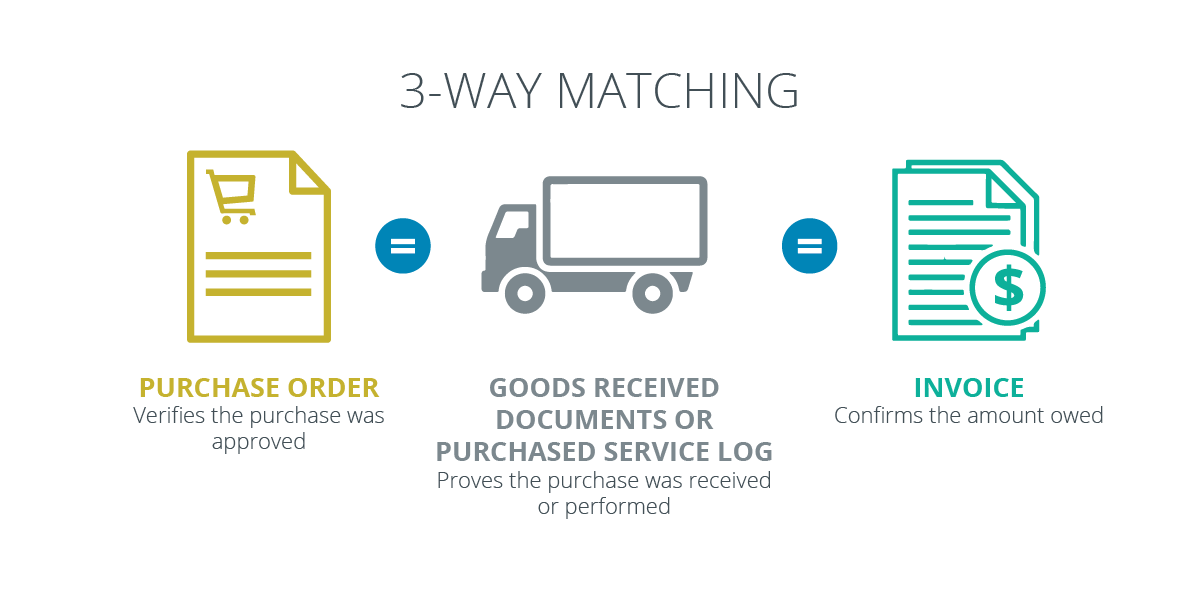Understanding Healthcare’s Procure to Pay Process
November 30, 2022
Taking on Healthcare’s Greatest Challenges in 2023
January 20, 2023Veering from the three-way matching process by not using a purchase order (PO) puts health systems at risk of erroneous transactions and a simple way of detecting potential fraud. According to our data, health systems do NOT use a PO on an average of 69% of transactions.*
What is a 3-way Match?
The three-way matching process is part of the procure to pay process (P2P) performed by the Accounts Payable (AP) department before paying invoices. AP cross-references the data in a PO, receipt records/logs, and invoice. If all data on all three documents match up, the invoice is paid. If there is a discrepancy the transaction is reviewed for incorrect data or potential fraud.
Benefits of Using 3-Way Matching on all Transactions at Your Health System
Reduced Manual Data Entry Errors
It’s no secret that human error exists in the form of data entry. However, the 3-way matching process helps uncover these errors before the slip of a finger costs the health systems millions.
Decreased Erroneous Transactions
Since the three-way matching process is a system of checks and balances by cross-referencing data, it should catch errors reducing the number of duplicate payments, overcharges, and other payment errors.
As previously mentioned, utilizing POs greatly reduces the number of inaccurate transactions due to the prevention of duplicate payments and its presence in the 3-way matching process. Without the PO, erroneous payments such as overpayments can easily slip through the cracks of a P2P process and expose health systems to risk. Without POs, a health system is 32% more likely to experience errors throughout the remaining P2P process.*
Increased Internal Controls
The three-way matching process is in itself a form of internal control to protect and prevent health systems from internal and external risk.
Internal Audit departments should work with AP to ensure health system's matching processes are correctly in place and encourage Supply Chain, Finance, and AP leaders to increase the percentage of transactions that utilize a three-way match.
Utilizing automation in the matching process increases internal controls as well, but is not a fool-proof solution to decreasing all transaction errors and fraud. All automation should be accompanied by a trained eye to catch anything that may still pass through the process.
Automation is only as good as the upstream data it is fed. For example, if a PO is wrong and the invoice is wrong, but they match, it will still get paid in error
Improved Vendor Relationships
Consistent errors result in consistent disruption to health system P2P processes and vendors’ workflows. Using the three-way matching process will save both sides time and energy in improving relationships while showing which vendors may be taking up too much time to resolve and may need to be replaced or held more accountable.
Reduced Risk of Fraud
Just as the PO and the matching process are important to reducing errors, it also plays a role in reducing fraud. The matching of data will weed out fake invoices when invoice data does not match receipts or POs.
Creation of an Audit Trail
Keeping an audit trail is always best practice in any operation or workflow. By documenting all information needed for a three-way match, all purchases can be audited to both recover money from any transactional errors and also for compliance and financial audits.
Tips for 3-Way Matching in AP
Manual three-way matching is time-consuming, but thresholds can help streamline the process. Thresholds can be set for the value of a purchase and the discrepancy of any non-matches to speed up workflow.
Value Thresholds
Health systems can set dollar value thresholds that allow lower-valued purchases to bypass the three-way matching process. This value will vary depending on the unique needs of the organization and P2P strategy.
Using value thresholds allows AP personnel to spend more of their time reviewing and resolving high-dollar-value purchases.
Discrepancy Thresholds
Another way to speed up the payment process is to allow for discrepancy thresholds. These are limits that allow payments of a certain percentage of the total purchase amount to be paid regardless of a match.
Whether using automation or manually matching documents, mistakes will happen and erroneous purchases will add up. We specialize in helping health systems create and optimize P2P workflows and controls by analyzing spend data and putting our 35+ years of experience to work. Reach out now to consult with one of our experts about how we can help your health system.
*TAG, Inc. uses over 35 years of health system data to provide industry insights into spend analysis and procure to pay processes exclusively at health systems.




